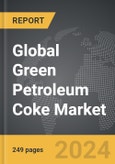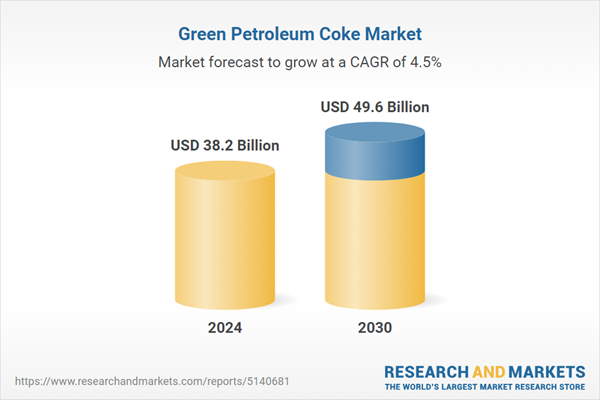Global Green Petroleum Coke Market - Key Trends & Drivers Summarized
What Role Does Green Petroleum Coke Play in Industrial Applications?
Green petroleum coke (GPC) is a critical raw material used across several industrial sectors, including aluminum, steel, and energy. Produced as a by-product in oil refineries, GPC is composed primarily of carbon and is a crucial feedstock in aluminum smelting, where it serves as an anode material. In the steel industry, GPC is utilized as a fuel and reducing agent, contributing to cost-effective production processes. As demand for aluminum and steel continues to rise in industries like automotive, construction, and packaging, GPC has become a key industrial commodity.Why Is Demand for Low-Sulfur GPC Increasing?
The demand for low-sulfur green petroleum coke is on the rise as industries aim to meet stricter environmental standards and reduce sulfur emissions. Sulfur in GPC can cause pollution and reduce the quality of end products, making low-sulfur variants highly desirable, especially in the aluminum and energy sectors. With regulatory pressures increasing on emissions, oil refineries are investing in desulfurization processes to produce cleaner GPC that meets quality and environmental standards. This demand for low-sulfur GPC is particularly prominent in regions with strict environmental regulations, driving the market for cleaner, high-quality coke.How Are Technological Advancements in Refining Impacting GPC Production?
Advancements in refining technologies are improving the production efficiency and quality of green petroleum coke. Innovations in delayed coking processes enable refineries to produce high-quality GPC with lower impurities and optimized carbon content, which is essential for industries with stringent material requirements. New refining techniques are also supporting the production of specialty grades of GPC for applications like carbon fiber and batteries, expanding its use beyond traditional markets. These technological advancements are helping refineries meet growing demand for cleaner and more versatile GPC.What Drives the Growth of the Green Petroleum Coke Market?
The growth in the green petroleum coke market is driven by factors such as increased demand from the aluminum and steel industries, the shift toward low-sulfur GPC, and advancements in refining technologies. The essential role of GPC in aluminum and steel production supports its steady demand, especially as these industries expand. The shift towards cleaner GPC variants, driven by environmental regulations, is prompting refineries to produce low-sulfur GPC to meet market needs. Furthermore, refining innovations are enhancing GPC quality and opening new application areas, positioning the market for continued growth as industries seek high-performance carbon materials.Report Scope
The report analyzes the Green Petroleum Coke market, presented in terms of units. The analysis covers the key segments and geographic regions outlined below.Segments: Form (Sponge Coke, Honeycomb Coke, Shot Coke, Needle Coke, Purge Coke).
Geographic Regions/Countries: World; United States; Canada; Japan; China; Europe (France; Germany; Italy; United Kingdom; and Rest of Europe); Asia-Pacific; Rest of World.
Key Insights:
- Market Growth: Understand the significant growth trajectory of the Sponge Coke segment, which is expected to reach US$17.0 Billion by 2030 with a CAGR of a 4.3%. The Honeycomb Coke segment is also set to grow at 5.4% CAGR over the analysis period.
- Regional Analysis: Gain insights into the U.S. market, valued at $10.2 Billion in 2024, and China, forecasted to grow at an impressive 4.2% CAGR to reach $7.9 Billion by 2030. Discover growth trends in other key regions, including Japan, Canada, Germany, and the Asia-Pacific.
Why You Should Buy This Report:
- Detailed Market Analysis: Access a thorough analysis of the Global Green Petroleum Coke Market, covering all major geographic regions and market segments.
- Competitive Insights: Get an overview of the competitive landscape, including the market presence of major players across different geographies.
- Future Trends and Drivers: Understand the key trends and drivers shaping the future of the Global Green Petroleum Coke Market.
- Actionable Insights: Benefit from actionable insights that can help you identify new revenue opportunities and make strategic business decisions.
Key Questions Answered:
- How is the Global Green Petroleum Coke Market expected to evolve by 2030?
- What are the main drivers and restraints affecting the market?
- Which market segments will grow the most over the forecast period?
- How will market shares for different regions and segments change by 2030?
- Who are the leading players in the market, and what are their prospects?
Report Features:
- Comprehensive Market Data: Independent analysis of annual sales and market forecasts in US$ Million from 2024 to 2030.
- In-Depth Regional Analysis: Detailed insights into key markets, including the U.S., China, Japan, Canada, Europe, Asia-Pacific, Latin America, Middle East, and Africa.
- Company Profiles: Coverage of players such as Aluminium Bahrain B.S.C, Asbury Carbons, Carbograf Industrial S.A. de C.V., Modern Industrial Investment Holding Group, Oxbow Corporation and more.
- Complimentary Updates: Receive free report updates for one year to keep you informed of the latest market developments.
Some of the 51 companies featured in this Green Petroleum Coke market report include:
- Aluminium Bahrain B.S.C
- Asbury Carbons
- Carbograf Industrial S.A. de C.V.
- Modern Industrial Investment Holding Group
- Oxbow Corporation
- Sinoway Carbon Co., Ltd.
Tariff Impact Analysis: Key Insights for 2025
Global tariff negotiations across 180+ countries are reshaping supply chains, costs, and competitiveness. This report reflects the latest developments as of April 2025 and incorporates forward-looking insights into the market outlook.The analysts continuously track trade developments worldwide, drawing insights from leading global economists and over 200 industry and policy institutions, including think tanks, trade organizations, and national economic advisory bodies. This intelligence is integrated into forecasting models to provide timely, data-driven analysis of emerging risks and opportunities.
What’s Included in This Edition:
- Tariff-adjusted market forecasts by region and segment
- Analysis of cost and supply chain implications by sourcing and trade exposure
- Strategic insights into geographic shifts
Buyers receive a free July 2025 update with:
- Finalized tariff impacts and new trade agreement effects
- Updated projections reflecting global sourcing and cost shifts
- Expanded country-specific coverage across the industry
Table of Contents
Companies Mentioned (Partial List)
A selection of companies mentioned in this report includes, but is not limited to:
- Aluminium Bahrain B.S.C
- Asbury Carbons
- Carbograf Industrial S.A. de C.V.
- Modern Industrial Investment Holding Group
- Oxbow Corporation
- Sinoway Carbon Co., Ltd.
Table Information
| Report Attribute | Details |
|---|---|
| No. of Pages | 249 |
| Published | April 2025 |
| Forecast Period | 2024 - 2030 |
| Estimated Market Value ( USD | $ 38.2 Billion |
| Forecasted Market Value ( USD | $ 49.6 Billion |
| Compound Annual Growth Rate | 4.5% |
| Regions Covered | Global |









